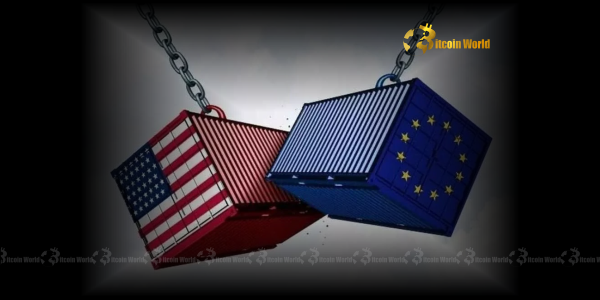BitcoinWorld

EU Tariffs: Looming Trade Crisis as EU Prepares €72B Retaliatory Tariffs Against US
In an increasingly interconnected global economy, events seemingly far removed from the cryptocurrency world can send significant ripples through it. When major economic blocs clash, the reverberations are felt across all asset classes, including the volatile crypto market. Recently, whispers of a brewing US Trade War have turned into a loud declaration, with the European Union signaling its readiness to unleash a massive wave of EU Tariffs. This isn’t just about goods and services; it’s about investor sentiment, market stability, and ultimately, the future trajectory of your digital assets.
Understanding the Looming Threat of EU Tariffs
The European Union, through its seasoned European Commissioner for Trade and Economic Security, Maroš Šefčovič, has made a stern announcement: a staggering 72 billion euros ($84 billion) in additional EU Tariffs are on the table. This isn’t a speculative threat but a calculated response to potential actions from the United States. The EU’s stance is clear: if trade talks with the U.S. falter, these tariffs will be imposed on U.S. imports. This substantial figure underscores the seriousness with which the EU views the escalating trade dispute, highlighting their commitment to protecting their economic interests. These potential tariffs are not merely punitive; they are a strategic measure designed to create leverage and deter aggressive trade policies from the other side.
Historically, tariffs have been a double-edged sword. While intended to protect domestic industries, they often lead to higher consumer prices, reduced trade volumes, and retaliatory measures from trading partners. The EU’s proposed tariffs would target a wide range of American goods, potentially impacting various sectors from agriculture to technology. The specific products targeted are often chosen for their political or economic sensitivity, aiming to maximize pressure on the opposing nation.
The Spark: The US Trade War and Its Origins
To fully grasp the current situation, it’s essential to look back at the catalyst. The specter of a US Trade War was first raised prominently when then-U.S. President Donald Trump announced his intention to impose a hefty 30% tariff on EU imports, effective August 1. This move was part of a broader ‘America First’ economic policy, which prioritized domestic production and aimed to reduce trade deficits by making imported goods more expensive. Trump’s administration had previously imposed tariffs on steel and aluminum imports from various countries, including EU members, and had threatened tariffs on automobiles, among other sectors.
This aggressive posture ignited a series of tit-for-tat exchanges, where one nation’s tariff imposition was met with a similar measure from the other. The underlying philosophy behind such actions is often to force renegotiation of trade agreements deemed unfair. However, the practical outcome frequently involves increased costs for businesses and consumers, supply chain disruptions, and heightened uncertainty in global markets. The threat of a 30% tariff from the U.S. on EU imports was particularly alarming due to its significant percentage and broad potential impact across European industries.
Key Aspects of the Initial US Tariff Threat:
- Targeted Goods: While not explicitly detailed in the initial announcement, such tariffs typically target a wide array of goods, from industrial machinery to consumer products, impacting various sectors within the EU.
- High Percentage: A 30% tariff is substantial, making U.S. goods significantly more expensive for European consumers and businesses, potentially reducing demand.
- Unilateral Action: The announcement reflected a unilateral approach to trade policy, often bypassing traditional multilateral trade dispute resolution mechanisms.
- Economic Nationalism: It underscored a broader shift towards economic nationalism, where domestic industries are prioritized, even at the expense of international trade relations.
The Mechanism of Retaliatory Tariffs: A Dangerous Cycle
The EU’s preparation of 72 billion euros in additional duties is a classic example of Retaliatory Tariffs. These are duties imposed by a country on imported goods from another country in response to the latter imposing tariffs on its exports. It’s essentially an economic tit-for-tat, designed to exert pressure and signal a strong response to perceived unfair trade practices. The goal is to make the initial aggressor reconsider their stance, but it often leads to an escalating cycle that can harm both economies involved.
When one major economic power imposes tariffs, the affected party has several options: accept the tariffs, challenge them through international bodies like the World Trade Organization (WTO), or impose their own retaliatory tariffs. The EU’s decision to prepare such a significant package indicates their preference for the latter, aiming to match the U.S. in economic leverage. The selection of goods for these Retaliatory Tariffs is strategic, often targeting products from politically sensitive regions or industries within the aggressor nation, aiming to maximize political pressure.
Potential Impacts of Retaliatory Tariffs:
| Stakeholder | Potential Impact |
|---|---|
| Consumers | Higher prices for imported goods, reduced variety. |
| Businesses (Importers/Exporters) | Increased costs, reduced competitiveness, disrupted supply chains, potential job losses. |
| Governments | Increased revenue from tariffs (initially), but potential for reduced overall economic growth and political friction. |
| Global Economy | Slower trade growth, increased uncertainty, potential for recession. |
Why Do Global Trade Tensions Matter to Everyone?
Beyond the immediate financial implications for businesses involved in import and export, rising Global Trade Tensions have far-reaching consequences that affect every individual, even those not directly involved in international trade. These tensions create an environment of uncertainty, which is kryptonite for economic growth and investor confidence. When major economies are at odds, it disrupts established supply chains, leading to higher production costs and, ultimately, increased prices for consumers. This phenomenon, known as inflation, erodes purchasing power and can lead to a general slowdown in economic activity.
Moreover, persistent trade disputes can strain diplomatic relations, making it harder for nations to cooperate on other critical global issues like climate change, cybersecurity, or public health crises. The interconnectedness of the modern world means that a trade dispute between two major players like the EU and the U.S. can send shockwaves across continents, affecting emerging markets, commodity prices, and even the stability of financial systems. It’s not just about tariffs; it’s about trust, stability, and the fundamental rules governing international commerce.
Consider the ripple effect: a company reliant on imported components faces higher costs due to tariffs. To maintain profit margins, they might pass these costs onto consumers, or they might seek alternative, potentially lower-quality, suppliers. This can lead to a decline in product quality or an increase in prices for end-users. Similarly, exporters facing retaliatory tariffs find their products more expensive and less competitive in foreign markets, potentially leading to reduced sales and job cuts. This web of consequences illustrates why Global Trade Tensions are a concern for policymakers, businesses, and citizens alike.
Analyzing the Broad Economic Impact on Markets, Including Crypto
The potential Economic Impact of an escalating trade war between the EU and the U.S. cannot be overstated. In traditional financial markets, such tensions typically lead to increased volatility, with investors seeking safe-haven assets like gold or certain government bonds. Equity markets often react negatively to news of tariffs, as they signal reduced corporate profits and economic uncertainty. Currency markets can also experience significant fluctuations as traders anticipate changes in trade balances and capital flows.
For the cryptocurrency market, the implications are multifaceted. While often seen as a hedge against traditional financial instability, crypto assets are not immune to macro-economic shocks. In times of heightened global uncertainty, Bitcoin and other major cryptocurrencies can exhibit dual behaviors:
- Risk-Off Asset: Sometimes, Bitcoin acts as a ‘digital gold,’ with investors flocking to it during periods of geopolitical or economic instability, viewing it as a decentralized alternative to traditional safe havens.
- Risk-On Asset: At other times, especially during sharp market downturns, crypto can behave like a ‘risk-on’ asset, falling in tandem with equities as investors liquidate assets across the board to cover losses or move to cash.
An escalating trade war would likely lead to a general risk-off sentiment across global markets. This could initially put downward pressure on cryptocurrencies as investors reduce exposure to all perceived ‘risky’ assets. However, if the traditional financial system shows signs of deeper distress, the narrative of crypto as a decentralized alternative could gain traction, potentially leading to a resurgence in demand. The key is increased volatility and unpredictability, making informed decision-making crucial for crypto investors.
Potential Economic Impact Scenarios:
- Reduced Global Growth: Tariffs act as taxes, increasing costs and reducing demand, which can lead to a slowdown in global economic expansion.
- Inflationary Pressures: Higher import costs are often passed on to consumers, leading to rising prices for goods and services.
- Supply Chain Disruptions: Businesses may struggle to source components or sell products across borders, forcing costly reconfigurations.
- Investor Uncertainty: Ambiguity surrounding trade policies makes investors hesitant, leading to reduced investment and market volatility.
- Currency Fluctuations: Trade imbalances can lead to significant shifts in currency values, impacting international trade and investment.
Navigating the Storm: Challenges and Actionable Insights
The prospect of a full-blown trade war presents significant challenges for businesses, consumers, and investors alike. The primary challenge is the unpredictability of outcomes. Trade disputes can escalate rapidly, or they can be resolved through last-minute negotiations. This uncertainty makes long-term planning difficult. For businesses, it means rethinking supply chains, sourcing strategies, and market entry points. For consumers, it could mean higher prices and fewer choices. For investors, it necessitates a careful re-evaluation of portfolio risk.
Key Challenges:
- Uncertainty: The fluid nature of trade negotiations makes it hard to predict the duration and intensity of disputes.
- Supply Chain Fragility: Globalized supply chains are vulnerable to disruptions from tariffs, leading to delays and increased costs.
- Market Volatility: Financial markets, including crypto, will likely experience heightened swings in response to trade news.
- Erosion of Trust: Trade disputes can damage international cooperation and trust, impacting future collaborations.
Actionable Insights for Investors:
While the broader geopolitical landscape is beyond individual control, investors can adopt strategies to mitigate risks and potentially capitalize on opportunities:
- Diversify Your Portfolio: Don’t put all your eggs in one basket. Consider a mix of traditional assets and cryptocurrencies. Within crypto, diversify across different asset classes (e.g., Bitcoin, Ethereum, stablecoins, DeFi tokens).
- Stay Informed: Keep a close eye on geopolitical developments and trade talks. Understanding the macro environment is crucial for making informed investment decisions. Follow reputable news sources and economic analyses.
- Risk Management: Implement strict risk management strategies. This includes setting stop-loss orders, avoiding over-leveraging, and only investing what you can afford to lose.
- Look for Resilience: In crypto, consider projects with strong fundamentals, real-world utility, and robust development teams that might be more resilient to market downturns driven by external factors. Stablecoins, for instance, can offer a temporary refuge during periods of high volatility.
- Long-Term Perspective: While short-term volatility is inevitable, maintaining a long-term perspective can help weather the storm. Focus on the underlying technology and adoption trends of cryptocurrencies.
A Compelling Summary: The Interconnectedness of Our World
The EU’s readiness to impose 72 billion euros in Retaliatory Tariffs against the U.S. is a stark reminder of the delicate balance in global trade relations. What begins as a dispute over specific goods can quickly escalate into a full-blown US Trade War, casting a long shadow over the entire global economy. These EU Tariffs are not just numbers on a balance sheet; they represent potential disruptions to supply chains, increased costs for consumers, and a significant dampener on economic growth. The resulting Global Trade Tensions underscore the profound interconnectedness of our world, where actions taken by major economic powers reverberate across all markets, including the dynamic and often unpredictable realm of cryptocurrency.
As investors, businesses, and consumers, staying vigilant and informed is paramount. While the immediate focus might be on traditional markets, the ripple effects will undoubtedly touch the crypto space, manifesting as increased volatility or shifts in investor sentiment. The ability to understand these macro-economic forces and adapt investment strategies accordingly will be crucial for navigating the challenging times ahead. The current situation serves as a powerful testament to the fact that no market exists in isolation, and the global economic health directly influences the trajectory of even the most innovative digital assets.
To learn more about the latest crypto market trends, explore our article on key developments shaping Bitcoin price action.
This post EU Tariffs: Looming Trade Crisis as EU Prepares €72B Retaliatory Tariffs Against US first appeared on BitcoinWorld and is written by Editorial Team





